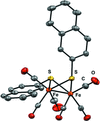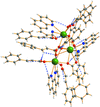issue contents
February 2018 issue

Cover illustration: The crystal structures of all higher hydrates of lithium halides have been determined. In each hydrate, the lithium cation is coordinated octahedrally. The dihydrates crystallize in the NaCl·2H2O or NaI·2H2O type structure. Surprisingly, in the tri- and pentahydrates of LiCl and LiBr, one water molecule per Li+ ion remains uncoordinated. See Sohr, Schmidt & Voigt [Acta Cryst. (2018), C74, 194-202].
research papers










































 journal menu
journal menu





































